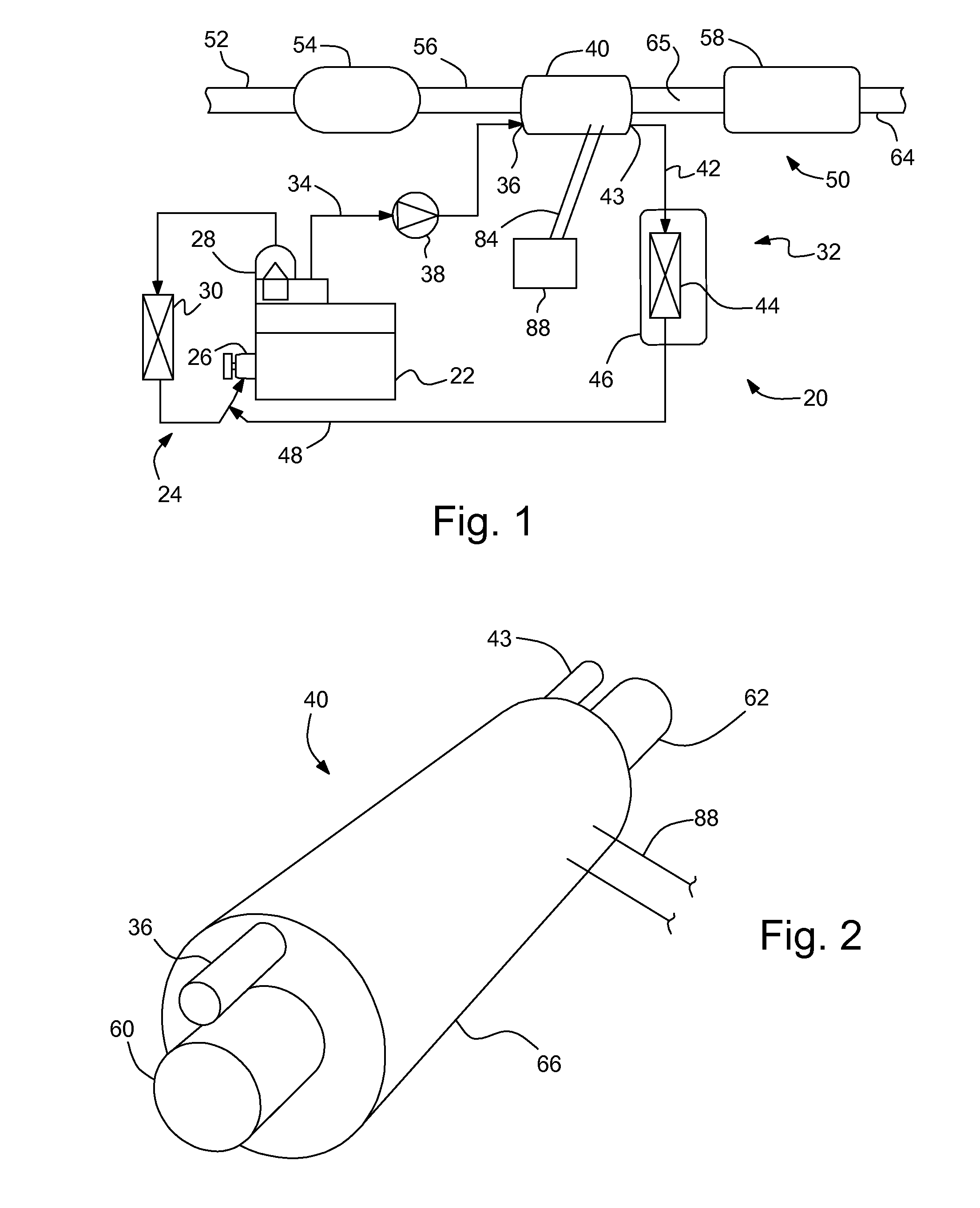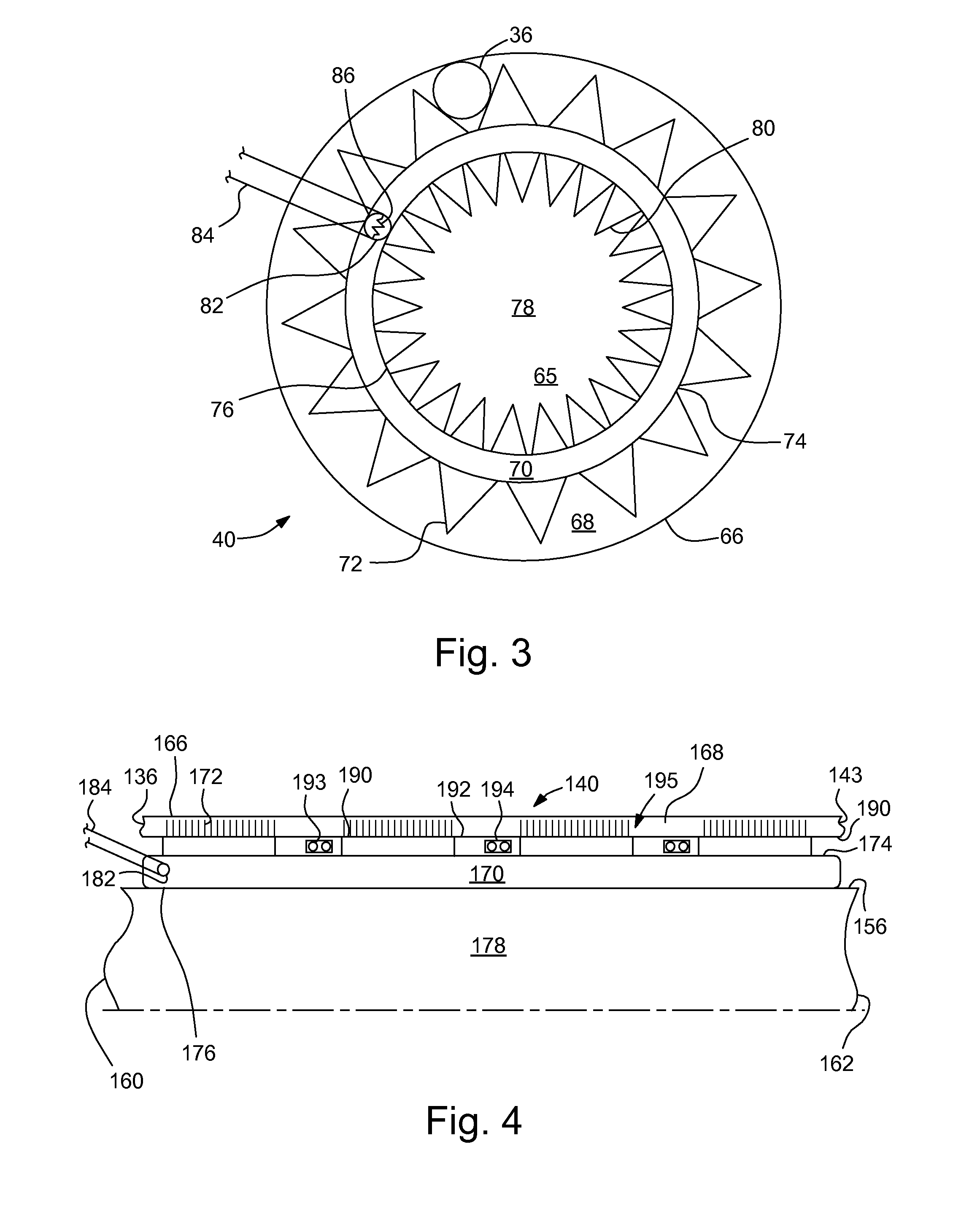Exhaust gas waste heat recovery
a waste heat recovery and exhaust gas technology, applied in the direction of combustion-air/fuel-air treatment, liquid displacement, separation process, etc., can solve the problems of unsatisfactory heat transfer, large waste of energy from combustion, and need for additional package space for bypass pipes and heat exchangers, so as to improve fuel economy and vehicle emissions, the effect of fast engine warm up and faster passenger cabin heating
- Summary
- Abstract
- Description
- Claims
- Application Information
AI Technical Summary
Benefits of technology
Problems solved by technology
Method used
Image
Examples
second embodiment
[0025]FIG. 4 illustrates a Since this embodiment is similar to the first, similar element numbers will be used for similar elements, but employing 100-series numbers.
[0026]In this embodiment, the intermediate exhaust pipe 156 forms or connects to the inner wall 176 of the vacuum chamber 170 to define the exhaust chamber 178 between the exhaust inlet 160 and the exhaust outlet 162 of the exhaust heat recovery heat exchanger 140. The vacuum chamber 170 is formed between the inner wall 176 and outer wall 174, with the hydride pellet 182 mounted therein and connected to electrical leads 184. The housing 166 forms an outer wall of a coolant chamber 168, between the coolant inlet 136 and coolant outlet 143, with coolant heat transfer fins 172 for increasing the surface area for heat transfer.
first embodiment
[0027]Unlike the first embodiment, this embodiment includes components between the outer wall 174 of the vacuum chamber 170 and an inner wall 190 of the coolant chamber 168. Thermoelectric devices 191 alternate with pockets of insulating material 192 and high temperature electrical conductors 193 in potting material 194 to create an electrical power generating assembly 195. The potting material 194 helps protect the electrical conductors 193 from the heat, while the insulation may be employed to reduce the heat transfer directly to the coolant (rather than through the thermoelectric devices 191). The thermoelectric devices 191 are oriented to have their hot sides facing the exhaust chamber 178 and their cold sides facing the coolant chamber 168.
[0028]When no heat transfer from the exhaust gasses is desired, the operation is the same as with the first embodiment. No electric current is supplied to the electric leads 184, so the hydride pellet 182 retains the hydrogen, making the vacu...
third embodiment
[0029]FIG. 5 illustrates a Since this embodiment is similar to the first, similar element numbers will be used for similar elements, but employing 200-series numbers. The elements discussed in this embodiment may be used in a vehicle or in stationary equipment.
[0030]In this embodiment, an assembly 222 that produces hot waste fluids, such as, for example, an engine, produces the hot fluids, such as exhaust gasses, that are directed through the pipe 252, an optional exhaust (or other fluid) treatment assembly 254, intermediate pipe 256, exhaust heat recovery heat exchanger 240, and an optional muffler 258 and tailpipe 264 (if for an engine exhaust system). Alternatively, the assembly 222 may be, for example, fuel cells. In this embodiment, the conduit 234 leading into the heat exchanger 240 may carry water or refrigerant (or other heat absorbing fluid) that is then directed through the second conduit 242 to a machine 296 driven by the hot fluid, such as, for example, a turbine. The t...
PUM
| Property | Measurement | Unit |
|---|---|---|
| electrical current | aaaaa | aaaaa |
| electric current | aaaaa | aaaaa |
| heat | aaaaa | aaaaa |
Abstract
Description
Claims
Application Information
 Login to View More
Login to View More - R&D
- Intellectual Property
- Life Sciences
- Materials
- Tech Scout
- Unparalleled Data Quality
- Higher Quality Content
- 60% Fewer Hallucinations
Browse by: Latest US Patents, China's latest patents, Technical Efficacy Thesaurus, Application Domain, Technology Topic, Popular Technical Reports.
© 2025 PatSnap. All rights reserved.Legal|Privacy policy|Modern Slavery Act Transparency Statement|Sitemap|About US| Contact US: help@patsnap.com



